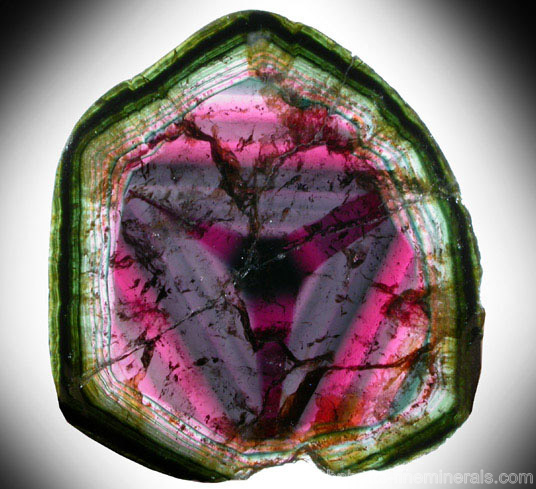The Mineral liddicoatite

Liddicoatite is an uncommon form of Tourmaline, almost identical in chemical composition to Elbaite, but with a calcium atom replacing a sodium atom in its chemical formula. Liddicoatite was not recognized as a separate Tourmaline species until 1977. Prior to that time, it was thought to be Elbaite. The original discovery of Liddicoatite in Madagascar was believed to be fully dominating in hydroxyl in its chemical formula. Subsequent analysis has determined a fluorine presence in place of some of the hydroxyl, though several localities (though not the type locality) do in fact contain all hydroxyl and no fluorine. The fluorine-rich Liddicoatite is recognized as a distinct mineral species by the IMA, and termed Fluor-liddicoatite. Liddicoatite is name after Richard T. Liddicoat (1918-2002), a well-known gemologist who was the president of the GIA, and inventor of the Diamond grading system.
Chemical Formula
Ca(Li,Al)3Al6(BO3)3Si6O18(OH)4
Color
Liddicoatite is a very colorful mineral. Colors include green, red, pink, purple, and and blue. White, colorless, black, brown, yellow, and orange colors also exist. Crystals are frequently multicolored, containing two or more distinct colors. Liddicoatite may also have internal color zoning and banding. Some specimens are pleochroic.
Properties
Streak
White |
Hardness
7.0 - 7.5 |
Transparency
Transparent to translucent |
Specific Gravity
3.0 - 3.1 |
Luster
Vitreous |
Cleavage
3,2 |
Fracture
Conchoidal to uneven |
Tenacity
Brittle |
Crystal Habits
Usually as elongated prismatic crystals that are heavily
striated. Also as short, stubby, prismatic crystals, which can be very wide. Crystals are often well-terminated on the top, and usually have a rounded, triangular cross-section. Also occurs in columnar aggregates. Liddicoatite crystals are occasionally doubly terminated, and can be found as floater crystals.
Varieties
-
Form of Liddicoatite where part of the hydroxyl is replaced with fluorine. Fluor-liddicoatite was recognized as a distinct mineral species by the IMA in 2011, with the following chemical formula: Ca(Li,Al)3Al6(BO3)3Si6O18(OH)3F
Uses
Liddicoatite forms outstanding and beautiful crystal which are highly regarded by collectors as a rare form of Tourmaline. Large crystals are often cut into thin cross-section slices and polished and sold to collectors in this form, with the multicolored designs and forms and inner crystal colors beautifully displaying. Especially popular are those slices with a triangular color pattern displaying within the core of the crystal. Liddicoatite is also be used as a Tourmaline gemstone, but its limited occurrences inhibit its use from being more widespread.
Noteworthy Localities
Liddicoatite is most well-known from the pegmatite fields of Madagascar. The primary locations where these Liddicoatite crystals come from are in Antananarivo Province, with the following locality, regional, or marketplace names: Antsirabé, Anjanabonoina, Antsongombato, Manapa, Vohitrakanga, and Sahatany. A new deposit in Madagascar was found in a different region in the Camp Robin area, Fianarantsoa Province. The Tourmalines that were recently discovered in Vietnam at the Minh Tien Mine in Luc Yen, Yenbai Province, Vietnam have also been determined to be Liddicoatite.
Common Mineral Associations
Quartz, Albite, Calcite, Muscovite, Beryl
Distingushing Similar Minerals
Elbaite - Locality is an indicator; otherwise cannot be determined without chemical analysis.